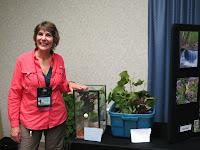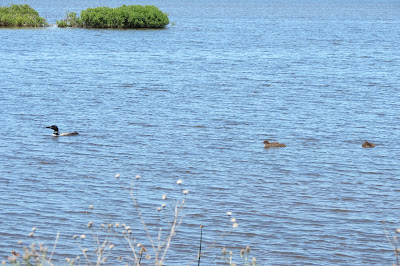Things are moving right along, here at the caterpillar ranch. Mostly is it all fun and games, but like any other ranch, there are chores to be done.
 |
| Cecropia caterpillars, 1st instar ( black) and recently shedded 2nd instar caterpillars. |
The "cats" are growing now, and since their skin does not stretch to accommodate their increasing girth, it is time to shed. The little black ball on the right side of the photo is actually the outer coat of a first stage insect, or instar. They shed in a way similar to a snake shedding its skin. The black cats are first instars. The brightly colored cats with red bobbles are second or third instar cats. Things are starting to get interesting!
 |
| Moving into larger quarters. |
It is time to move the brood to larger quarters. I have a lovely Victorian case that lends itself to this task. One might think this case is suited to fine collectibles, flowers or plants, but it suits my caterpillars just fine. It is a roomy high-rise for the critters.
I am not a big one for tightly contained wild animals- whether they be tigers, or tiger swallowtails. If you don't have room, time or energy to properly and humanely raise and feed caterpillars, then- please DON'T.
Mostly I do this for educational purposes. It is a time, space and endurance commitment and it is not for everyone.
 |
| Feeding caterpillers create "frass," and lots of it. |
This is one day of waste from a few tiny creatures. Wait till you see how much waste material can be created by nearly mature, full sized silk-moth caterpillars!
The "barn" needs shoveling out, so I call in my ranch hands. The neighbor kids are bright and interested in learning more about raising lepidoptera. I "Tom Sawyer" them into cleaning my caterpillar's palace.
If I do any traveling this moth, I will need a highly qualified back-up crew to feed this lot of hungry, hungry caterpillars. I want to make certain they are trained and ready.
Step 1: Wash all foodstuffs.
A CRITICAL component of raising caterpillars is the appropriate food. We are feeding wild cherry and offering a few other options as well. I offered some apple leaves, but I noticed the caterpillar on the apple leaves died. I fear that tree is too close to the farm field at my yard's edge. I suspect pesticide drift is the culprit, and now we will stick to leaves from trees deep within my woods.
No matter, all plant material MUST be washed thoroughly. We don't want spiders are other predators coming in with our greens.
Rule of thumb: If you aren't finding things, you aren't washing enough.
 |
| A looper of some sort was hiding in the vegetation gathered for feeding. |
I found this interesting caterpillar while washing boughs. There is no real fear it will harm my Cecropias, so it will be allowed to remain in the crystal caterpillar palace as well.
 |
| Water plants, but add a paper towel dam. |
Keep the plant material fresh by placing it in water, otherwise the leaves will dehydrate and not be too palatable for our cats. Unfortunately, caterpillars are not too bright. Do not leave the water exposed, or cats will crawl in head-first and drown. I learned this one the hard way!
The whole point of raising caterpillars should be: to increase their odds for survival. So if you are thinking about raising lepidoptera, please be attentive to their needs. Otherwise, just leave them outside and let nature take care of them. The best rule is "first do no harm."
My lovely ranch-hand has cleaned the glass house, restocked the feeding material, and placed the old leaves holding caterpillars into the fresh material. We do not handle caterpillars with our hands, as we could be carrying harmful bacteria or fungus. The less we mess with them the better. Our ranch strives to raise organically feed, healthy, happy moths and butterflies. This is not a business, and no amount of money would make this much work worth the pay. The early instars are the easy part. Wait 'til you see the
frass-for-all that lies ahead!
Warning: Raising a whole mess of caterpillars is a lot like getting a puppy. It always
seems like a good idea, until you get about halfway into the process. That's when you'll understand why I love having ranch hands!

















.JPG)
+Rocks.JPG)

.JPG)
+Shelly,+Cheryl+John+Boyd.JPG)
















